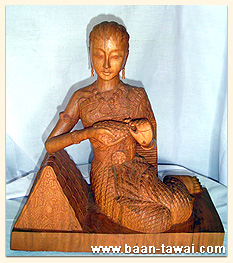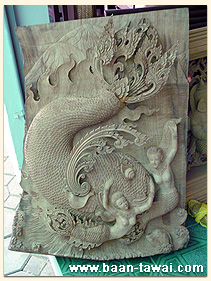Wood-carving
Wood-carving is a form of sculpture. Wood carving is different from other types of sculpture however as its method is cutting out the unwanted part. Then the remaining part is a piece of work . Wood-carving expresses the beauty and the neatness of culture of Thailand. According to the former Thai law, wood carving was one of the ten important crafts of Thailand. Wood carving has always been recognized by the government and at present is classed under the ‘Department of Art'.
Instruments used in wood-carving
| • |
Gouges : a long sharp piece of steel with a wooden handle. Various shapes and sizes of gouges are used in carving wood e.g. digging gouge, bent gouge , finger-nail gouge etc |
| • |
Knife : used for smoothening over the surface of the wood, at the first step of wood carving work |
| • |
Sharpening stone : used for sharpening gouges |
| • |
Mallet : made from hard wood for knocking the gouge on carving |
| • |
Stamps : used for making picture e.g. flower, on the wood surface |
| • |
Drawing materials : used for drawing the pattern from the draft lines on the wood before carving |
| • |
Mook' or ‘Samook' (Decorating strip) : used for decorating the wooden piece by sticking it across the model |
Wood Carving
The northern part of Thailand is well known for the wealth of teak. Teak is the most expensive wood. The teak logs were transported to Bangkok while the ‘cut-offs' were left for the villagers to use. They made use of it in varouis ways. Teak carving became the symbol of Chiangmai. During the old days, a Chiangmai wood- carver would go into the forest with the necessary tools to work on a big trunk of teak. For the small piece of teak , they took it back to work at home. Woodcarving is now so popular that the wood carvers needs to buy wood for their work. This makes its price is much higher.
The history of wood carving
Thai people are very adapt in the art of woodcarving. This can be seen throughout history ; Buddha Image carving, graceful temple doors, church buildings, neatly carved fruit, the stone carving at the Wall of Chettupont Temple, the wood-carved picture at the beginning of Rattanakosin Reign at the National Museum.
Woodcarving is a rural art . Generally, it has been seen in the northern part of Thailand. Since then there have been numerous teak objects as vilagers tried to make many different uses of the remaining of teak from the trunk. They made ornaments for their home of local animals such as elephants. The skill of wood carving has been passed down from generation to generation.
 Material and equipment used in wood carving Material and equipment used in wood carving
| • |
Wood |
| • |
Knife |
| • |
Gouges |
| • |
Sharpening stone |
| • |
Mallets |
| • |
Saws |
| • |
Planes |
| • |
Files and Rasps |
| • |
Stamps |
| • |
Drawing material |
Steps and methods of wood carving
Step 1 : |
Designing the work pattern |
Step 2 : |
Selecting wood |
Step 3 : |
Copying the work pattern on the wood |
Step 4 : |
Carving |
Step 5 : |
Decorating |
Wood Decorating
There are two types of wood decorating;
1. Focussing on wood texture : Since the natural texture of the wood Is so beautiful they use gouges to reflect the various texture of the different woods, and the decorator wood therefore not be allowed to paint over the cut or the wood texture. Instead , it is covered with varnish and polished with the soft cloth so that the wax can seep into the wood.
2. Not focussing on wood texture : This is when they are focussing on the whole components of the wood pieces, on the detail of the decorative pattern and on the decorative material e.g. cut glass, leather, rope, cloth etc including the paint .
Apart from this, there's an imitation of the ancient style piece, the method is the same way as the above accompanied by an antiquing method. Examples of the kind of work can be seen in Buddha Images, dancing puppets, angels, giiants and many more items.
Material and equipment used in wood decorating

| • |
Sand paper |
| • |
Brush |
| • |
Small brush |
| • |
Wax |
| • |
Paint |
| • |
Thinner |
| • |
Gold plate and gold dust |
| • |
Lacquer |
| • |
Stamps |
| • |
Drawing material |
| • |
Varnish |
| • |
White cement |
| • |
‘Chun' (a mixture of Mook) |
| • |
Latex |
| • |
Cut glass |
| • |
Small bench |
| • |
Flat stick |
|